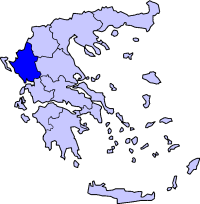Epirus (periphery)
| Epirus Periphery Περιφέρεια Ηπείρου |
|
|---|---|
 |
|
| Country: | |
| Capital: | Ioannina |
| Prefectures: | Arta Ioannina Preveza Thesprotia |
| Population: | 358,698
(2005) |
| Area: | 9,203 km² (3,553 sq.mi.) |
| Density: | 39 /km² (101 /sq.mi.) |
| Website: | www.roe.gr |
Epirus (Greek: Ήπειρος, Ípiros), is a periphery in northwestern Greece. It borders the peripheries of West Macedonia and Thessaly to the east, Stereá Elláda (Central Greece) to the south, the Ionian Sea and the Ionian Islands to the west and Albania to the north. The province has an area of about 9,200 km² (3,551 square miles). It is part of the wider historical region of Epirus, which overlaps modern Albania and Greece but mostly lies in Greek territory.
Contents |
Geography and ecology
Greek Epirus, like the region as a whole, is rugged and mountainous.It comprises the land of the ancient Molossians and Thesprotians[1] and a small part of the land of the Chaonians the greater part being in Southern Albania. It is largely made up of mountainous ridges, part of the Dinaric Alps. The periphery's highest spot is on Mount Smolikas, at an altitude of 2.637 metres above sea level. In the east, the Pindus Mountains that form the spine of mainland Greece separate Epirus from Macedonia and Thessaly. Most of Epirus lies on the windward side of the Pindus. The winds from the Ionian Sea offer the region more rainfall than any other part of Greece.
The Vikos-Aoos and Pindus National Parks are situated in the Ioannina Prefecture of the periphery. Both areas have imposing landscapes of dazzling beauty as well as a wide range of fauna and flora. The climate of Epirus is mainly alpine. The vegetation is made up mainly of coniferous species. The animal life is especially rich in this area and includes, among other species, bears, wolves, foxes, deer and lynxes.

Government

Epirus is divided into four prefectures (nomoi), which are further subdivided into dēmoi (municipalities) or koinótētes (roughly equivalent to British or Australian shires).
The prefectures are:
- Thesprotia
- Ioannina
- Arta
- Preveza
Cities
- Ioannina
- Arta
- Preveza
- Igoumenitsa
- Metsovo
- Paramythia
- Parga
- Syvota
- Konitsa
Economy
Epirus has few resources or industries and its rugged terrain makes agriculture difficult. Sheep and goat pastoralism have always been an important activity in the periphery (Epirus provides more than 45% of meat to the Greek market) but there seems to be a decline in recent years. Tobacco is grown around Ioannina, and there is also some farming and fishing, but most of the area's food must be imported from more fertile regions of Greece. Epirus is home to a number of the country's most famous dairy products' brands, which produce feta cheese among others.
Demographics
Around 350,000 people live in Epirus. According to the 2001 census, it has the lowest population of the 13 peripheries of Greece. This is partly due to the impact of repeated wars in the 20th century as well as mass emigration due to adverse economic conditions. The capital and largest city of the region is Ioannina, where nearly a third of the population lives. The great majority of the population are Greeks, but the province also includes one of Greece's largest concentrations of Aromanians, people who tend to identify with the Greek population. Greece does not officially recognize minorities other than the Greek Muslim minority in Thrace, therefore it is difficult to estimate the size of the Aromanian populations.
According to research conducted by a Romanian ethnographer in 1994, native Albanian is dying fast, and attempts to find Albanian-speakers in the region proved unsuccessful.[2]
The delineation of the border between Greece and Albania in 1913 left a number of Albanian-populated villages on the Greek side of the border (and the Greek-populated villages and cities in the region called Northern Epirus on the Albanian). Some Albanians view this territory as part of a region that they call Chameria (Thesprotia in Greek), formerly parts of it were populated by a minority, the Cham Albanians along with the majority ethnic Greeks.
References
- ↑ Winnifrith, T.J. Badlands-Borderland: A History of Southern Albania/Northern Epirus. London: Duckworth Publishers, 2003, ISBN-10: 0715632019, p. 8. "The Thesprotians lived in the western part of what is now Greek Epirus, the Molossians in the rest of Greek Epirus, and the Chaonians in the southern section of Southern Albania..."
- ↑ Winnifrith, Tom J. "Southern Albania, Northern Epirus: Survey of a Disputed Ethnological Boundary" (Society Farsarotul Home).
External links
|
|||||||
|
|||||||